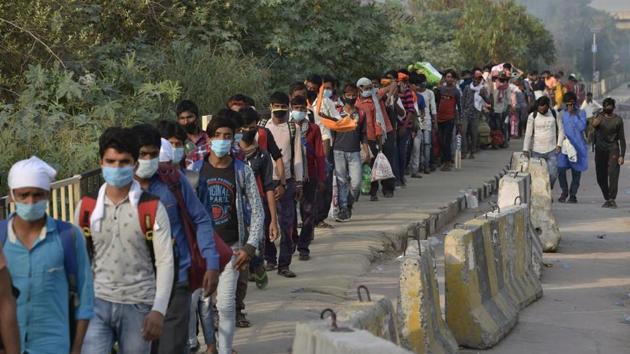The migrant worker crisis needs a multipronged response
Among other things, it needs comprehensive data and statistics on workers, with a category-wise breakdown into skill, sector and gender at the state and national level
The images of migrant labourers’ trudging home, some on top of trucks or walking barefoot, with women and children in tow, have shaken the nation’s conscience. Tragic accidents with injuries and loss of life have evoked sympathy. However, the images of the Narendra Modi government’s Operation Shramik Express, which has helped over four million migrants return home by buses and special trains, is reassuring.

In India, migrant labour are woven into the waft and weft of the economic fabric. It is a measure of the national economic integration as also of regional and rural-urban disparities that force migrants from weaker states to go to metros and other states in search of livelihood. They contribute to the prosperity of their home and destination states, while empowering themselves.
The sudden and unavoidable coronavirus disease (Covid-19)-related lockdown threatens to unravel this fabric. The fragility of the migrant worker-based productive capacities stands exposed. Of the 40 million migrant labourers affected, the blue-collar – the informal sector – workers are the face of multidimensional poverty, inequality and unrealised demographic dividend. Their mass exodus from host states has created a humanitarian and health security challenge and an unprecedented logistical nightmare.
It complicates the government’s attempts to stem the contagion. It poses a longer-term risk of labour dislocation and atrophy. It has already impacted post-lockdown economic activities announced under the Atmanirbhar Bharat Abhiyan.
The Opposition parties have both stoked and used migrant workers’ conundrum to critique the government’s Covid-19 strategy. As concerned stakeholders, they must recognise the gravity of the calamity and the enormity of the response it requires. Modi, on his part, is driving India’s stupendous response to the crisis in the spirit of cooperative and consultative federalism of antyodaya, with empathy for the predicament of the poor, including the pravasi shramiks (migrant labourers).
A highly infectious and novel virus, Covid-19 has pushed the state and central governments into the uncharted policy and action territory, without the availability of any vaccine or treatment. Unlike China, which militarily enforced the lockdown of a similar scale and scope, doing so in a democracy like India – a socially and federally diverse, but economically weak country – poses a unique challenge. The migrant crisis is emblematic of this, and needs special initiatives.
States are empowered to decide on the extension and enforcement of the lockdown, and are responsible for providing migrants relief in situ. The Centre, therefore, had to persuade states to agree to the mass transportation of workers with attendant risks of contagion. Some chief ministers have been proactive, while others are hesitant and unprepared. For instant impact during disasters, a Centre-state protocol must be established.
It is equally important to collect and update comprehensive migrant worker-related data and statistics, going beyond the 10-year Census exercise – categorising them into skill, sector and gender at the state and national level. Its absence has blindsided us on the scale of the migrant labour challenge and frustrated efforts to reach them to help with food, cash transfers, health services, shelter or relocation to home/host states.
The other side of the coin is the information asymmetry poor migrants faced. Many were unable to access information on the relief, benefit and transport provided by various governments. Many became prey to disinformation, unscrupulous touts, and motivated panic-mongers. Establishing well-functioning hotlines, building outreach systems, and providing low-cost smartphones and IT education are crucial.
Many migrant workers left cities due to the fear of disease and stigma, evictions by landlords, confinement in congested conditions, job losses, income and food insecurity and the psychological impulse to be with their families. Yet, many continued to stay in cities due to pull factors of better wages, jobs, prospects of better economic and upward social mobility. To allow workers to exercise real choices, India must maximise the development of all the states in a sustainable manner.
The challenge migrant workers face on return to home states includes resistance from their communities fearing infection and a lack of income and employment. As economic activities rekindle, many workers have already started moving back. Governments should provide for their sustenance, local employment and return to host states.
Targeted and ecosystem support to migrant workers is a substantial chunk of the mega-economic revival and transformation package of Rs 20 lakh crore. An abhiyan or a movement for migrant workers’ welfare and empowerment must be driven in collaboration with state governments on a warfooting.
It should: One, ramp up and prioritise direct and short-term food, cash, shelter and health support. Two, fast track the implementation measures on local infrastructure and supply chains, technology diffusion, liquidity, employment, income and entrepreneurship generation. Three, synergistically implement measures to support other vulnerable groups and micro, small and medium enterprises. Four, ensure migrant workers’ wellbeing and utilisation of their potential.
In this moment of creative destruction, migrant workers’ wellbeing and unleashing the Ganga of their potential is vital to our survival and India’s economic rebirth.
Lakshmi Puri is a former assistant secretary general, United Nations, former deputy executive director of UN Women, and former acting deputy secretary general of UNCTAD
The views expressed are personal





